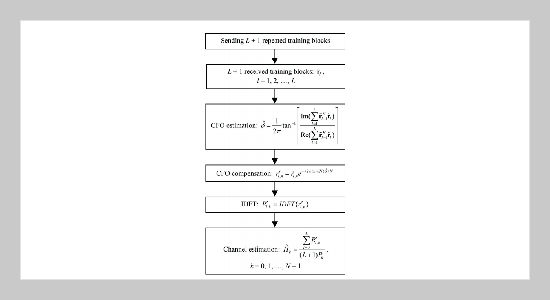REFERENCES
- [1] Classen, F. and Meyr, H., “Frequency Synchronization Algorithms for OFDM Systems Suitable for Communication over Frequency Selective Fading Channels,” IEEE Veh. Technol. Conf., 1994 June 8-10; Stockholm; pp. 1655�1659 (1994).
- [2] Moose, P. H., “A Technique for Orthogonal Frequency Division Multiplexing Frequency Offset Correction,” IEEE Trans. Commun., Vol. 42, pp. 2908�2914 (1994).
- [3] van de Beek, J. J., Sandell, M. and Borjesson, P. O., “ML Estimation of Time and Frequency Offset in OFDM Systems,” IEEE Trans. Signal Process, Vol. 45, pp. 1800�1805 (1997).
- [4] Schmidl, T. M. and Cox, D. C., “Robust Frequency and Timing Synchronization for OFDM,” IEEE Trans. Commun., Vol. 45, pp. 1613�1621 (1997).
- [5] Choi, Y.-S., Voltz, P. J. and Cassara, F. A., “ML Estimation of Carrier Frequency Offset for Multicarrier Signals in Rayleigh Fading Channels,” IEEE Trans. Veh. Technol., Vol. 50, pp. 644�655 (2001).
- [6] Keller, T., Piazzo, L., Mandarini, P. and Hanzo, L., “Orthogonal Frequency Division Multiplex Synchronization Techniques for Frequency-Selective Fading Channels,” IEEE J. Sel. Areas Commun., Vol. 19, pp. 999�1008 (2001).
- [7] Salberg, B.-B. and Swami, A., “Doppler and Frequency-Offset Synchronization in Wideband OFDM,” IEEE Trans. Wireless. Commun., Vol. 4, pp. 2870� 2881 (2005).
- [8] Ma, X., Kobayashi, H. and Schwartz, S. C., “Joint Frequency Offset and Channel Estimation for OFDM,” IEEE GLOBECOM, Dec. 1-5; 2003, pp. 15�19 (2003).
- [9] Freda, M. M., Weng, J. F. and Le-Ngoc, T., “Joint Frequency Offset and Channel Estimation in OFDM Systems,” International Conference on Wireless Network, Communications, and Mobile Computing, pp. 1089� 1093 (2005).
- [10] Minn, H., Bhargava, V. K. and Letaief, K. B., “A Combined Timing and Frequency Synchronization and Channel Estimation for OFDM,” IEEE Trans. Commun., Vol. 54, pp. 416�422 (2006).
- [11] Pun, M.-O., Morelli, M. and Kuo, C.-C. J., “Maximum-Likelihood Synchronization and Channel Estimation for OFDMA Uplink Transmissions,” IEEE Trans. Commun., Vol. 54, pp. 726�736 (2006).
- [12] Meyer, P. L., Introductory Probability and Statistical Applications, 2nd ed. Reading, MA: Addison-Wesley (1970).
- [13] Kim, Y. H., Song, I., Kim, H. G., Chang, T. and Kim, H. M., “Performance Analysis of a Coded OFDM System in Time-Varying Multipath Rayleigh Fading Channels,” IEEE Trans. Veh. Technol., Vol. 48, pp. 1610�1615 (1999).
- [14] Proakis, J. G., Digital Communications, 4th ed. New York: McGraw-Hill (2001).
- [15] Falconer, D. D. and Ariyavisitakul, S. L., “Broadband Wireless Using Single Carrier and Frequency Domain Equalization,” Int. Symp. Wireless Pers. Multimedia Commun., 2002 Oct. 27-30; Honolulu, Hawaii; pp. 27�36 (2002).
- [16] Yen, R. Y., Liu, H.-Y. and Tsai, W. K., “QAM Symbol Error Rate in OFDM Systems over Frequency-Selective Fast Ricean Fading Channels,” IEEE Trans. Veh. Technol., Vol. 57, pp. 1322�1325 (2008).
- [17] Alouini, M.-S. and Goldsmith, A., “A Unified Approach for Calculating Error Rates of Linearly Modulated Signals over Generalized Fading Channels,” IEEE Trans. Commun., Vol. 47, pp. 1324�1334 (1999).
















